Sensor Sweep: John Steinbeck’s Werewolf Novel, Gardner Fox, Roger Zelazny
Monday , 24, May 2021 Sensor Sweep 1 CommentFiction (The Guardian): Years before becoming one of America’s most celebrated authors, John Steinbeck wrote at least three novels which were never published. Two of them were destroyed by the young writer as he struggled to make his name, but a third – a full-length mystery werewolf story entitled Murder at Full Moon – has survived unseen in an archive ever since being rejected for publication in 1930.
Reviews (Larry Correia): this post is about writers dealing with attack dog bully critics, not legit critics who read your stuff and don’t like it. Bad reviews happen to everyone. But you don’t have to put up with the assholes who weaponize the review system just to screw with writers. This is about the scumbags who want to financially hurt writers just because the broken system makes it so they can.
Writers (DMR Books): Gar Fox was born in 1911, almost exactly five years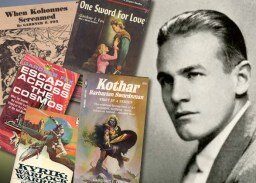 after Robert E. Howard. A native of Brooklyn, he grew up reading the pulps. When he was eleven, Fox was given two of Edgar Rice Burroughs’ Barsoom novels. After that, he “read all of Burroughs, Harold Lamb, Talbot Mundy” that he could find. It should be noted that about the only way that Fox could’ve read Mundy and Lamb in the early 1920s would be by way of the mighty pulp, Adventure.
after Robert E. Howard. A native of Brooklyn, he grew up reading the pulps. When he was eleven, Fox was given two of Edgar Rice Burroughs’ Barsoom novels. After that, he “read all of Burroughs, Harold Lamb, Talbot Mundy” that he could find. It should be noted that about the only way that Fox could’ve read Mundy and Lamb in the early 1920s would be by way of the mighty pulp, Adventure.
Fantasy (Goodman Games): While J.R.R. Tolkien may be the most famous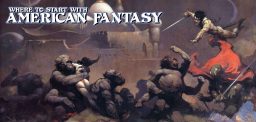 and ubiquitous of fantasy writers, introducing generations of readers the world over to fantasy fiction through The Hobbit and influencing the way such stories are forever told with his masterwork, The Lord of the Rings, American letters has perhaps contributed more profoundly to the development of the modern secondary world fantasy story. From the pulpsters of early 20th century magazine fiction that first combined elements of weird horror with historical adventure to create sword-and-sorcery, to later writers adding their distinct stamp to fantasy in a post-Tolkien world, the tradition of American fantasy is a rich and varied one.
and ubiquitous of fantasy writers, introducing generations of readers the world over to fantasy fiction through The Hobbit and influencing the way such stories are forever told with his masterwork, The Lord of the Rings, American letters has perhaps contributed more profoundly to the development of the modern secondary world fantasy story. From the pulpsters of early 20th century magazine fiction that first combined elements of weird horror with historical adventure to create sword-and-sorcery, to later writers adding their distinct stamp to fantasy in a post-Tolkien world, the tradition of American fantasy is a rich and varied one.
Anime (Kairos): Some of the most enduring memories from my dissolute youth in the anime scene revolve in some way around Kentaro Miura’s masterpiece Berserk. Whether it was crowding around a buddy’s CRT monitor to binge watch the visceral anime or blasting the soundtrack on the way to a con, Berserk set the rumbling bassline to my otaku years.
youth in the anime scene revolve in some way around Kentaro Miura’s masterpiece Berserk. Whether it was crowding around a buddy’s CRT monitor to binge watch the visceral anime or blasting the soundtrack on the way to a con, Berserk set the rumbling bassline to my otaku years.
Writing (Pulp Rev): Action scenes are the most memorable aspects of any fiction. Fast-paced and intense, they sear themselves into the audience’s memories. Battles between the hero and the lesser mooks punctuate the plot, while the final showdown between the hero and the villain serves as the climax of the story. And that is what action in storytelling is: a climax. A climax that must be built up to.
Science Fiction (Scifi Wright): The subject of this talk is the theology of science fiction and fantasy stories. An alert student will notice immediately that, technically speaking, there is no subject to this subject matter. There is no such thing as the theology of science fiction. Theology is reasoning about divine things; even the finest science fiction stories hardly fit into that category, much as fans like me idolize them. So I am arguing that there is no theology in science fiction, but there is something like it. To this end, I would like to submit to your candid judgment the following propositions:
Tolkien (Alas Not Me): ‘I shall’ and ‘I will’ at The Council of Elrond. ‘I will take the Ring, though I do not know the way.’ These are perhaps some of the best known words said by Frodo in all of The Lord of the Rings, often quoted and commented upon. ‘I shall’, however, is the normal way to express the future tense in the first person singular. Before commenting upon the choice Tolkien made here in preferring ‘will’ to ‘shall’, it will be useful to examine the times character say ‘I shall’ and ‘I will’ throughout the discussion in The Council of Elrond. Let’s start with ‘I shall’. It is the default, and there are only three instances.
D&D (Grognardia): One of the most overlooked – or perhaps simply forgotten – aspects of Original Dungeons & Dragons is that it was the referee who generates each player character’s ability scores. As stated in Volume 1 of OD&D: Prior to the character selection by players it is necessary for the referee to roll three six-sided dice in order to rate each as to various abilities, and thus aid them in selecting a role.
Appendix N (Goodman Games): By virtue of his unusual last name, Roger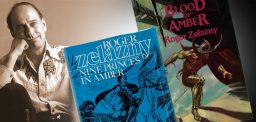 Zelazny is last in Appendix N. This author wonders: “How many readers have never gotten all the way down the list, leaving Zelazny a mystery?” And so, around the anniversary of his birth, let’s take a look at this three-time Nebula Award winner (nominated 14 times), six-time Hugo Award winner (coincidentally, also 14 nominations) and “last-but-by-no–means-least” author, focusing on his best-known work: The Chronicles of Amber.
Zelazny is last in Appendix N. This author wonders: “How many readers have never gotten all the way down the list, leaving Zelazny a mystery?” And so, around the anniversary of his birth, let’s take a look at this three-time Nebula Award winner (nominated 14 times), six-time Hugo Award winner (coincidentally, also 14 nominations) and “last-but-by-no–means-least” author, focusing on his best-known work: The Chronicles of Amber.
Classic Fiction (Rough Edges): I’ve been aware of the character Sexton Blake for many, many years, having first seen the name on paperbacks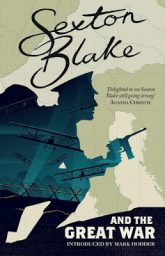 during the Sixties, none of which I ever owned or read. Over time I learned more about him: inspired by the success of Sherlock Holmes, Blake is another British Great Detective (he even lives in Baker Street) who solved cases in hundreds of stories and novels by dozens of authors, published in story papers and magazines from the 1890s through the 1960s. He has a young assistant, Tinker, and a faithful bloodhound, Pedro, and they had all sorts of adventures ranging from traditional mysteries to high adventure to espionage thrillers.
during the Sixties, none of which I ever owned or read. Over time I learned more about him: inspired by the success of Sherlock Holmes, Blake is another British Great Detective (he even lives in Baker Street) who solved cases in hundreds of stories and novels by dozens of authors, published in story papers and magazines from the 1890s through the 1960s. He has a young assistant, Tinker, and a faithful bloodhound, Pedro, and they had all sorts of adventures ranging from traditional mysteries to high adventure to espionage thrillers.
Art (Neo Text Corp): Lehr worked in a variety of media, including oils, acrylics (sometimes in combination with oil), and gouache, often on masonite or wood panel, and signed every work with a scripted “Lehr”. And when he wasn’t painting, he spent his time creating three-dimensional constructions that would later become an important part of his artistic output.
acrylics (sometimes in combination with oil), and gouache, often on masonite or wood panel, and signed every work with a scripted “Lehr”. And when he wasn’t painting, he spent his time creating three-dimensional constructions that would later become an important part of his artistic output.
Fiction (According to Quinn): Once upon a time 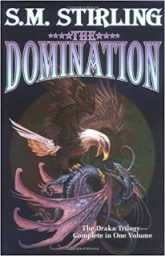 at DragonCon, author S.M. Stirling said that books typically make good miniseries and short stories make good movies. I’m an administrator of a Facebook group dedicated to his works and recently the possibility of films or TV series based on his notorious Draka series from the late 1980s and early 1990s came up. This set the wheels spinning–I’m inclined to think that each of the three main books would make for a good three-hour TV miniseries.
at DragonCon, author S.M. Stirling said that books typically make good miniseries and short stories make good movies. I’m an administrator of a Facebook group dedicated to his works and recently the possibility of films or TV series based on his notorious Draka series from the late 1980s and early 1990s came up. This set the wheels spinning–I’m inclined to think that each of the three main books would make for a good three-hour TV miniseries.
Games (R’lyeh Reviews): As its title suggests Bayt al Azif – A magazine for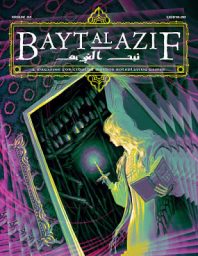 Cthulhu Mythos roleplaying games is a magazine dedicated to roleplaying games of Lovecraftian investigative horror. Published by Bayt al Azif it includes content for both Call of Cthulhu, Seventh Edition from Chaosium, Inc. and Trail of Cthulhu from Pelgrane Press, which means that its content can also be used with Delta Green: The Role-Playing Game and The Fall of DELTA GREEN. Published in November, 2020, Bayt al Azif Issue #03 does not include any content for use with the latter two roleplaying games
Cthulhu Mythos roleplaying games is a magazine dedicated to roleplaying games of Lovecraftian investigative horror. Published by Bayt al Azif it includes content for both Call of Cthulhu, Seventh Edition from Chaosium, Inc. and Trail of Cthulhu from Pelgrane Press, which means that its content can also be used with Delta Green: The Role-Playing Game and The Fall of DELTA GREEN. Published in November, 2020, Bayt al Azif Issue #03 does not include any content for use with the latter two roleplaying games
Lovecraft (Tentaculii): New on Archive.org, Mirages fanzine for Summer 1966. This has “Some Backgrounds to Fairyland” (1932) by one H.P. Lovecraft. So far as I can tell this essay is otherwise not online and is only available in print in either Collected Essays, Volume 3: Science or Marginalia (1944). The same fanzine issue also has a 12-page “Chronology” for the life/work of Clark Ashton Smith, though I expect this has probably been superseded since the late 1960s.
Sword & Sorcery (DMR Books): The connection between Fantasy and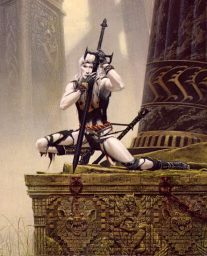 Sword and Sorcery is easy enough to see, but what kind of sub-class of Fantasy should Sword and Sorcery call home? Should it fit closer to the Low or to the High Fantasy fields? “Low fantasy is defined as a subcategory of the fantasy genre that is identified by supernatural occurrences encroaching on the real (primary) world” (Carmody, “High Fantasy vs Low Fantasy: A Detailed Guide”). “High fantasy is defined as a sub-genre of the broader category of fantasy that is characterized by extravagant characters and a massive fictional world that is extensively detailed.”
Sword and Sorcery is easy enough to see, but what kind of sub-class of Fantasy should Sword and Sorcery call home? Should it fit closer to the Low or to the High Fantasy fields? “Low fantasy is defined as a subcategory of the fantasy genre that is identified by supernatural occurrences encroaching on the real (primary) world” (Carmody, “High Fantasy vs Low Fantasy: A Detailed Guide”). “High fantasy is defined as a sub-genre of the broader category of fantasy that is characterized by extravagant characters and a massive fictional world that is extensively detailed.”
Games (The Jolly DM): Travel rules in 2D20 Conan RPG are fairly arbitrary in my own opinion and are left to the machinations of the GM. I am OK with that. But sometimes, I like to have a little randomness to it. I wanted some rules to follow, but I wanted to keep the rules in line with the mechanics of the game and simple to use. I am pretty confident that others may have developed similar ideas to what mine is like. But what ever. So I sat down and decided to see if I could write up something that I could use.
Review (Por Por Books Blog): The sci-fi boom that followed the success of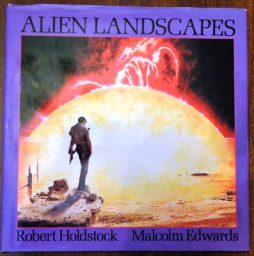 Star Wars led to a surge of books devoted to genre art, and one of the foremost of these was ‘Alien Landscapes’. This is one of two coffee-table books co-authored by the late Robert Holdstock (1948 – 2009) and Malcolm Edwards (b. 1949), the other being ‘Realms of Fantasy’ (1983). At 120 pages in length, measuring 11 1/2 x 11 1/4 inches, this is a well-made art book, printed on heavy stock with a library-friendly hardcover binding.
Star Wars led to a surge of books devoted to genre art, and one of the foremost of these was ‘Alien Landscapes’. This is one of two coffee-table books co-authored by the late Robert Holdstock (1948 – 2009) and Malcolm Edwards (b. 1949), the other being ‘Realms of Fantasy’ (1983). At 120 pages in length, measuring 11 1/2 x 11 1/4 inches, this is a well-made art book, printed on heavy stock with a library-friendly hardcover binding.
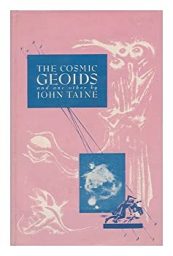 Fiction (Fantasy Literature): it was perhaps these news reports that caused Scottish-born mathematician/sci-fi author John Taine to make them the subject of his 14th fictional volume, The Cosmic Geoids and One Other. This book collected two novella-length works by Taine, both of them dealing with — of all things — the negative effects of insufficient vitamin dosages. Like so many other Taine works, this collection has never been reprinted since its initial appearance in 1949. The book was released as a $3 hardcover by Fantasy Publishing Company (not to be confused with Fantasy Press, which had released Taine’s 13th piece of fiction, 1947’s The Forbidden Garden) in a limited edition of 1,200 copies.
Fiction (Fantasy Literature): it was perhaps these news reports that caused Scottish-born mathematician/sci-fi author John Taine to make them the subject of his 14th fictional volume, The Cosmic Geoids and One Other. This book collected two novella-length works by Taine, both of them dealing with — of all things — the negative effects of insufficient vitamin dosages. Like so many other Taine works, this collection has never been reprinted since its initial appearance in 1949. The book was released as a $3 hardcover by Fantasy Publishing Company (not to be confused with Fantasy Press, which had released Taine’s 13th piece of fiction, 1947’s The Forbidden Garden) in a limited edition of 1,200 copies.
Firearms (Frontier Partisans): I’m guessing that few of us would include the bolt-action Mauser Rifle in the pantheon — but it certainly belongs there. Consider that one of the great frontier tribes treated the Mauser as a kind of cultural talisman. Speaking of the Boers, of course. When tensions between the Boer Republics of South Africa and the British Empire stretched to the snapping point at the very end of the 19th Century, General Ben Viljoen said it was time to resort to: “Vertroue in God en die Mauser” (faith in God and the Mauser rifle).
the bolt-action Mauser Rifle in the pantheon — but it certainly belongs there. Consider that one of the great frontier tribes treated the Mauser as a kind of cultural talisman. Speaking of the Boers, of course. When tensions between the Boer Republics of South Africa and the British Empire stretched to the snapping point at the very end of the 19th Century, General Ben Viljoen said it was time to resort to: “Vertroue in God en die Mauser” (faith in God and the Mauser rifle).
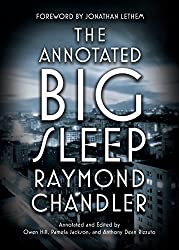 Raymond Chandler (Isegoria): I recently mentioned that Neovictorian’s Sanity nudged me to read (and then comment on) The Maltese Falcon and then The Big Sleep. The introduction to my annotated copy of The Big Sleep is full of interesting tidbits, like this 1950 reflection from Chandler: “I arrived in California with a beautiful wardrobe, a public school accent, no practical gifts for earning a living, and a contempt for the natives that, I am sorry to say, persists to this day.”
Raymond Chandler (Isegoria): I recently mentioned that Neovictorian’s Sanity nudged me to read (and then comment on) The Maltese Falcon and then The Big Sleep. The introduction to my annotated copy of The Big Sleep is full of interesting tidbits, like this 1950 reflection from Chandler: “I arrived in California with a beautiful wardrobe, a public school accent, no practical gifts for earning a living, and a contempt for the natives that, I am sorry to say, persists to this day.”
New (Rough Edges): It started out as a silly idea to bring buyers back to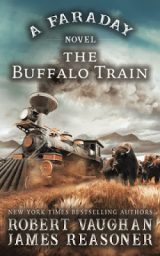 Abilene. Wrangle some buffalo, put them on a train, and ship them to Chicago so folks back east could see the massive, shaggy beasts with their own eyes. The concept seemed sound. What could go wrong? But for John Creed, agent for the famed Faraday Security Service, it was anything but simple. First, Hank Miles was willing to do whatever was required to prevent the plan from succeeding.
Abilene. Wrangle some buffalo, put them on a train, and ship them to Chicago so folks back east could see the massive, shaggy beasts with their own eyes. The concept seemed sound. What could go wrong? But for John Creed, agent for the famed Faraday Security Service, it was anything but simple. First, Hank Miles was willing to do whatever was required to prevent the plan from succeeding.
Games (Nerdist): Solomon Kane is an atmospheric game of storytelling, 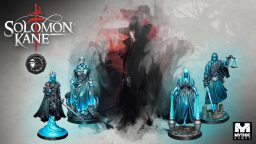 resource management, and tactical miniatures for one to four players ages 14+. Players choose one of four Virtues—Courage, Prudence, Temperance, or Justice—and use their special abilities to aid Kane in his struggle against the forces of darkness. Tales unfold in acts played in one game session each. Players’ actions determine how the chapters of each act end. The acts inside the box culminate in one grand tale of Solomon Kane’s journey, determined by you and your friends.
resource management, and tactical miniatures for one to four players ages 14+. Players choose one of four Virtues—Courage, Prudence, Temperance, or Justice—and use their special abilities to aid Kane in his struggle against the forces of darkness. Tales unfold in acts played in one game session each. Players’ actions determine how the chapters of each act end. The acts inside the box culminate in one grand tale of Solomon Kane’s journey, determined by you and your friends.
Good one from Correia, as usual.
Always nice to see a Cheah post at PULPREV.
Sexton Blakew has certainly had a lasting presence/influence over in Merry Olde. It’s cool that he has a bloodhound.
I would be totally up for some sort of Draka movie/series, especially DRAKON.
I’d never seen that essay by HPL on the ‘Little People’! Fascinating stuff.
Good write-up on frontier Mausers.